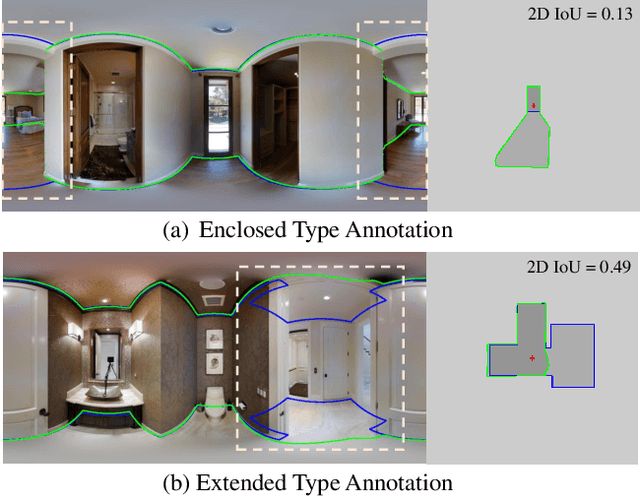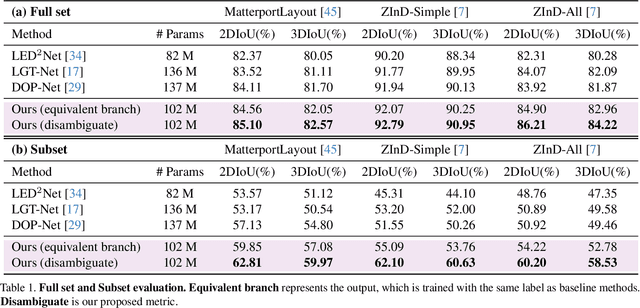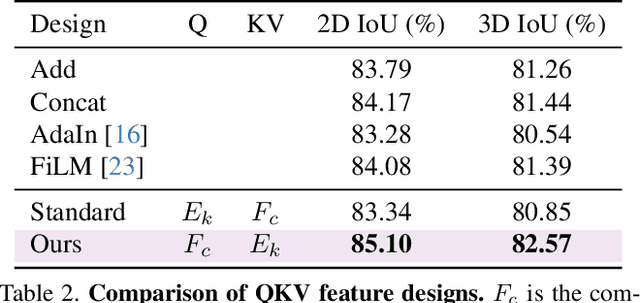Albert Y. C. Chen
OpenM3D: Open Vocabulary Multi-view Indoor 3D Object Detection without Human Annotations
Aug 27, 2025Abstract:Open-vocabulary (OV) 3D object detection is an emerging field, yet its exploration through image-based methods remains limited compared to 3D point cloud-based methods. We introduce OpenM3D, a novel open-vocabulary multi-view indoor 3D object detector trained without human annotations. In particular, OpenM3D is a single-stage detector adapting the 2D-induced voxel features from the ImGeoNet model. To support OV, it is jointly trained with a class-agnostic 3D localization loss requiring high-quality 3D pseudo boxes and a voxel-semantic alignment loss requiring diverse pre-trained CLIP features. We follow the training setting of OV-3DET where posed RGB-D images are given but no human annotations of 3D boxes or classes are available. We propose a 3D Pseudo Box Generation method using a graph embedding technique that combines 2D segments into coherent 3D structures. Our pseudo-boxes achieve higher precision and recall than other methods, including the method proposed in OV-3DET. We further sample diverse CLIP features from 2D segments associated with each coherent 3D structure to align with the corresponding voxel feature. The key to training a highly accurate single-stage detector requires both losses to be learned toward high-quality targets. At inference, OpenM3D, a highly efficient detector, requires only multi-view images for input and demonstrates superior accuracy and speed (0.3 sec. per scene) on ScanNet200 and ARKitScenes indoor benchmarks compared to existing methods. We outperform a strong two-stage method that leverages our class-agnostic detector with a ViT CLIP-based OV classifier and a baseline incorporating multi-view depth estimator on both accuracy and speed.
GenRC: Generative 3D Room Completion from Sparse Image Collections
Jul 19, 2024Abstract:Sparse RGBD scene completion is a challenging task especially when considering consistent textures and geometries throughout the entire scene. Different from existing solutions that rely on human-designed text prompts or predefined camera trajectories, we propose GenRC, an automated training-free pipeline to complete a room-scale 3D mesh with high-fidelity textures. To achieve this, we first project the sparse RGBD images to a highly incomplete 3D mesh. Instead of iteratively generating novel views to fill in the void, we utilized our proposed E-Diffusion to generate a view-consistent panoramic RGBD image which ensures global geometry and appearance consistency. Furthermore, we maintain the input-output scene stylistic consistency through textual inversion to replace human-designed text prompts. To bridge the domain gap among datasets, E-Diffusion leverages models trained on large-scale datasets to generate diverse appearances. GenRC outperforms state-of-the-art methods under most appearance and geometric metrics on ScanNet and ARKitScenes datasets, even though GenRC is not trained on these datasets nor using predefined camera trajectories. Project page: https://minfenli.github.io/GenRC
No More Ambiguity in 360° Room Layout via Bi-Layout Estimation
Apr 15, 2024



Abstract:Inherent ambiguity in layout annotations poses significant challenges to developing accurate 360{\deg} room layout estimation models. To address this issue, we propose a novel Bi-Layout model capable of predicting two distinct layout types. One stops at ambiguous regions, while the other extends to encompass all visible areas. Our model employs two global context embeddings, where each embedding is designed to capture specific contextual information for each layout type. With our novel feature guidance module, the image feature retrieves relevant context from these embeddings, generating layout-aware features for precise bi-layout predictions. A unique property of our Bi-Layout model is its ability to inherently detect ambiguous regions by comparing the two predictions. To circumvent the need for manual correction of ambiguous annotations during testing, we also introduce a new metric for disambiguating ground truth layouts. Our method demonstrates superior performance on benchmark datasets, notably outperforming leading approaches. Specifically, on the MatterportLayout dataset, it improves 3DIoU from 81.70% to 82.57% across the full test set and notably from 54.80% to 59.97% in subsets with significant ambiguity. Project page: https://liagm.github.io/Bi_Layout/
GDA: Generalized Diffusion for Robust Test-time Adaptation
Apr 02, 2024



Abstract:Machine learning models struggle with generalization when encountering out-of-distribution (OOD) samples with unexpected distribution shifts. For vision tasks, recent studies have shown that test-time adaptation employing diffusion models can achieve state-of-the-art accuracy improvements on OOD samples by generating new samples that align with the model's domain without the need to modify the model's weights. Unfortunately, those studies have primarily focused on pixel-level corruptions, thereby lacking the generalization to adapt to a broader range of OOD types. We introduce Generalized Diffusion Adaptation (GDA), a novel diffusion-based test-time adaptation method robust against diverse OOD types. Specifically, GDA iteratively guides the diffusion by applying a marginal entropy loss derived from the model, in conjunction with style and content preservation losses during the reverse sampling process. In other words, GDA considers the model's output behavior with the semantic information of the samples as a whole, which can reduce ambiguity in downstream tasks during the generation process. Evaluation across various popular model architectures and OOD benchmarks shows that GDA consistently outperforms prior work on diffusion-driven adaptation. Notably, it achieves the highest classification accuracy improvements, ranging from 4.4\% to 5.02\% on ImageNet-C and 2.5\% to 7.4\% on Rendition, Sketch, and Stylized benchmarks. This performance highlights GDA's generalization to a broader range of OOD benchmarks.
 Add to Chrome
Add to Chrome Add to Firefox
Add to Firefox Add to Edge
Add to Edge